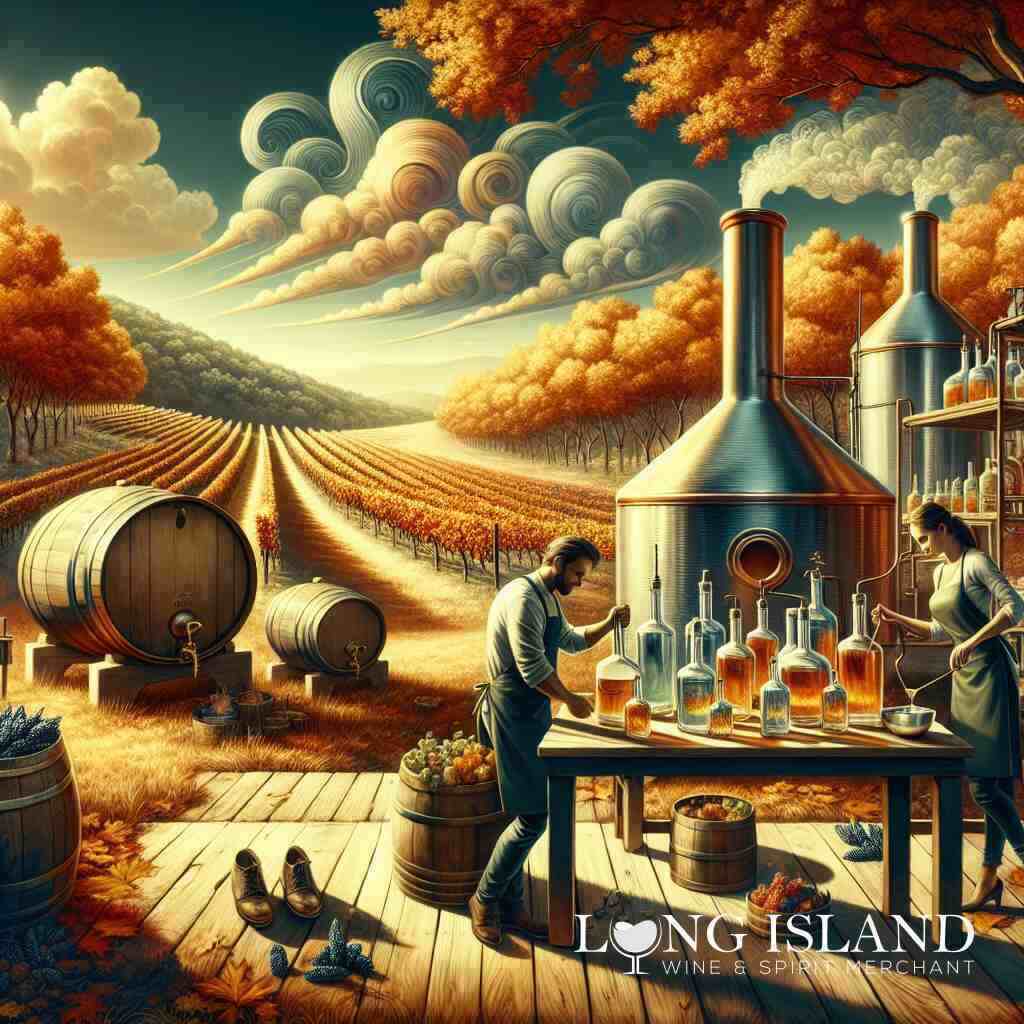
What is Port Wine? Origin, Types & Distillate Process
May 24, 2024
Introduction to the Rich Tradition of Port Wine
Defining Port Wine
Port wine, a sweet, fortified wine from Portugal, stands as a symbol of meticulous craftsmanship and centuries-old traditions. Known for its rich, intense flavors and remarkable versatility, Port wine offers a unique experience for wine enthusiasts. This delightful beverage is produced exclusively in the Douro Valley of Portugal, a region celebrated for its natural beauty and optimal grape-growing conditions. The essence of Port wine lies in its fortification process, where the addition of grape spirit, or aguardiente, halts fermentation, retaining the natural sweetness of the grape while boosting the alcohol content. This process not only distinguishes Port from other wines but also contributes to its longevity and complexity.
The Heritage of Portuguese Wine
Portuguese wine history is as deep and flavorful as the wines themselves. Dating back thousands of years, this history reflects a landscape rich with tradition and innovation. Portugal’s winemaking legacy is interwoven with the fortunes of its maritime exploration, which expanded its horizons and introduced Portuguese wines to the world. Within this rich tapestry, Port wine emerged in the 17th century as a serendipitous solution to preserve the wine for long sea voyages, fostering its international reputation and demand. Today, the heritage of Portuguese wine, especially Port, is celebrated worldwide, symbolizing the country’s enduring connection to craftsmanship, quality, and the global culinary tapestry.
Douro Valley: The Birthplace of Port
The Douro Valley, an area of breathtaking natural beauty, is the heartland of Port wine production. This region’s rugged terrain and unique microclimate create the perfect conditions for the cultivation of grape varieties used in Port wine. The Douro’s terraced vineyards, a UNESCO World Heritage site, not only illustrate the human effort to harness nature but also represent the deep respect and harmony between land and winemaker. The process of creating Port wine in this region is a blend of tradition and innovation, with generations of knowledge passed down through families. From the harvesting of grapes by hand to the treading in lagares (traditional stone tanks), every step embodies a celebration of both the region’s heritage and the timeless allure of Port wine.
In the Douro Valley, the symbiosis between the environment and winemaking is evident. The schistous soil and the contoured landscape, river valleys, and varied altitudes play a crucial role in the distinctive character of Port Wine. This terroir not only influences the flavor profiles of the wine but also challenges and inspires winemakers to create expressions of Port that are as diverse as they are delightful. Explore Port Wine on Long Island to experience a curated selection that celebrates this rich tradition.
The Art of Making Port Wine
Harvesting the Grapes
The process of creating Port wine begins in the steeply terraced vineyards of the Douro Valley, where a mix of manual labor and precision dictates the pace of the harvest. Grapes destined for Port wine are picked with careful attention to their ripeness, ensuring that they contain the perfect balance of sugar, acidity, and flavor. This meticulous selection process is crucial, as the inherent quality of the grapes forms the backbone of the wine’s character. Commack, New York’s appreciation for such artisanal methods is reflected in Long Island Wine & Spirit Merchant’s curated selection of Long Island wines and spirits, underscoring the community’s commitment to showcasing products that embody a labor of love and tradition.
Fermentation and the Role of Natural Yeasts
After harvesting, the grapes undergo fermentation, a transformative phase where the natural sugars are converted into alcohol by native yeasts. In traditional Port winemaking, this process occurs in large tanks or, more historically, in granite lagares where the grapes were once foot-trodden. The aim is to initiate a natural fermentation that is later interrupted to preserve the wine’s sweetness. The role of natural yeasts, integral to the wine fermentation process, imparts unique flavors and complexities, mirroring the terroir’s indigenous qualities. This natural approach to fermentation is a testament to the winemaker’s craftsmanship and the region’s biodiversity.
The Distillation and Fortification Process
Port wine distinguishes itself during the fortification phase, where grape spirit, or aguardiente, is added to the partially fermented wine. This action halts fermentation, preserves the wine’s natural grape sugars, and increases its alcohol content. The timing of this process is critical and requires the winemaker’s expertise to achieve the desired balance of sweetness and alcohol signature characteristic of Port wine. This delicate balance is what makes Port a rich, luscious wine, catering to those who seek depth and intensity in their glass.
Aging: Oak Barrels and the Passage of Time
Aging is where Port wine truly comes into its own, developing its complex flavors and aromatic profile over time. Depending on the style of the Port, it may age in oak barrels or large stainless steel tanks, with each vessel imparting distinct qualities. Oak aging, in particular, allows the wine to breathe and evolve, softening its textures and integrating its flavors. Tawny Ports, for instance, spend many years in barrels, acquiring a characteristic nuttiness and a complex bouquet as they mature. This passage of time is not merely a wait but a carefully monitored evolution, reflecting the subtlety and depth of the art of winemaking-a philosophy embraced and shared with customers at Long Island Wine & Spirit Merchant, located in the heart of Commack, New York, where the spirit of wine culture is celebrated and nurtured.
Types of Port Wine Unveiled
Ruby Port: The vibrant and fruity variety
Ruby Port is the embodiment of freshness and youth in the world of Port wines. Characterized by its deep, vibrant red color, Ruby Port offers a straightforward, intensely fruity experience with minimal oak aging. This variety captures the essence of the grapes at their peak, preserving their bright, berry-like flavors. As a result, Ruby Port is often the most accessible type of Port, making it an excellent introduction for those new to Port wine tasting. Its freshness and simplicity make it a favorite among those who seek a less complex but thoroughly enjoyable Port wine experience. Ruby Ports are ideal for casual savoring or as an accompaniment to chocolate desserts, bringing out the richness of both the wine and the food. Discover more about the allure of Ruby Port and its place among fine wines at the wine-tasting blog by Long Island Wine & Spirit Merchant.
Tawny Port: Elegance through aging
Tawny Port is a testament to the elegance that comes with careful aging in oak barrels. Unlike Ruby Port, Tawny Port undergoes extended aging, often for decades, allowing for a transformation in both color and flavor. This aging process results in a Port that is lighter in color, ranging from amber to golden brown, and boasts a complexity of flavors including caramel, nuts, and spices. Tawny Port is a nuanced, smooth drink that appeals to the refined palate, offering layers of flavors that unfold with each sip. The meticulous aging process Tawny Ports undergo is a tribute to the tradition and expertise of Portuguese winemakers, creating a wine that is as rich in history as it is in flavor. Enjoying a glass of Tawny Port is an experience that transcends mere drinking, inviting a contemplative appreciation of time and craftsmanship.
White Port: A versatile and refreshing choice
White Port stands out as a versatile and refreshing option within the spectrum of Port wines. Made from white grape varieties, this type presents a range of styles from dry to sweet, catering to a wide variety of taste preferences. White Port is often enjoyed as an aperitif, served chilled or even mixed in cocktails, offering a lighter alternative to its red counterparts. It can boast flavors of ripe stone fruits, nuts, and a hint of citrus, making it a delightful choice for warm weather sipping or as the basis for innovative drink creations. The adaptability of White Port, combined with its unique flavor profile, makes it an exciting choice for both traditionalists and adventurous drinkers alike.
Vintage Port: The epitome of quality and tradition
Vintage Port represents the pinnacle of Port wine craftsmanship, produced only in years that are declared as exceptional by the Port houses. This type is made from the best grapes of a single vintage year and is aged in barrels for a short period before bottling, where it then continues to mature for many years, even decades. Vintage Port is highly sought after for its intensity, structure, and potential for complexity as it ages, developing a broad range of flavors from concentrated berry fruit to chocolate, spices, and floral notes. A well-aged Vintage Port is a remarkable experience, offering a taste of history and the culmination of years of meticulous care and expertise. It is a celebration of the winemaker’s art, a treasure for collectors, and a sublime treat for those fortunate enough to taste it.
Late Bottled Vintage Port: Between tradition and modernity
Late Bottled Vintage (LBV) Port offers a bridge between the tradition of Vintage Port and the accessibility of more frequently bottled varieties. LBV Ports are made from grapes of a single vintage, similar to Vintage Ports, but are aged in barrels for a longer period before bottling, typically four to six years. This extended aging period allows LBV Ports to mature and develop their character while still in the barrel, making them ready to drink soon after bottling with no need for further aging. LBV Ports provide a taste of the Vintage Port experience, including the depth and complexity, but at a more accessible price point and without the necessity for extensive cellaring. They are an excellent way for wine enthusiasts to explore the qualities of Vintage Port while enjoying the immediacy and convenience that comes with LBV Ports.

Savoring Port Wine: Tasting and Pairing Essentials
Understanding Port Wine Tasting Notes
Port Wine offers an exquisite tapestry of flavors and aromas that can transport wine enthusiasts on a sensory journey like no other. Recognizing the nuances of Port’s tasting notes requires an attentive palate and a bit of knowledge. From the lush, fruit-forward notes of Ruby Port to the complex, oak-aged character of Tawny Port, each style presents a unique profile. For instance, Vintage Ports often reveal layers of berry, plum, and chocolate, while White Ports can hint at citrus, nutmeg, and almond. The key to appreciating these tasting notes is patience and practice. Immersing oneself in the Ultimate Guide to Port Wine in Long Island for 2024 can greatly enhance one’s understanding and enjoyment of these diverse and rich flavors.
Mastering Port Wine and Cheese Pairings
Pairing Port Wine with cheese is an art form that combines textures and flavors to elevate the tasting experience. The richness and intensity of Port make it a perfect companion to a wide variety of cheeses. For a classic pairing, try a vintage Port with a strong, blue cheese such as Stilton or Roquefort. The powerful flavors of the cheese are beautifully balanced by the wine’s sweetness, creating a harmony of tastes. Tawny Ports, with their nutty undertones, pair splendidly with aged cheddars or Gouda, offering a satisfying contrast of tastes and textures. This harmonious coupling not only delights the palate but also showcases the versatility of Port Wine as a complement to sophisticated cheese boards.
Creative Culinary Pairings with Port Wine
Beyond cheese, Port Wine’s richness makes it an excellent match for a variety of dishes, offering endless opportunities for creative culinary explorations. Ruby Port’s vibrant fruitiness cuts through the richness of chocolate desserts, providing a balanced and luxurious finish. Conversely, the nuanced complexity of an aged Tawny Port can beautifully accompany savory dishes, such as slow-roasted meats or rich, creamy sauces. Incorporating Port Wine into recipes-whether as a reduction for a decadent sauce or a key ingredient in a dessert-can add depth and intensity to the flavors, transforming a simple dish into something truly memorable. The adaptability and rich profile of Port open up a world of gastronomic possibilities for those willing to experiment in the kitchen.
Serving Suggestions for an Optimal Experience
To fully appreciate Port Wine, serving it at the right temperature and in the proper glassware is essential. Generally, Ruby and Vintage Ports should be served slightly below room temperature, around 60-64°F (15-18°C), to enhance their vibrant fruit flavors. Tawny and White Ports, known for their subtler profiles, are best enjoyed slightly chilled, between 54-58°F (12-14°C). Using the appropriate Port wine glasses, with their distinct shape designed to concentrate the wine’s aromas, allows for a fuller sensory experience. Decanting is recommended for Vintage Ports to separate the wine from any sediment and to oxygenate the wine, unlocking its full bouquet of aromas. Following these serving suggestions ensures that every sip of Port Wine is savored to its fullest, creating an unforgettable tasting journey.
The Science and Tradition Behind Port Wine Aging
The Impact of Aging on Flavor Profiles
The aging process of Port Wine is a fascinating alchemy where time and tradition blend to craft flavors of unparalleled depth and complexity. As Port Wine matures, either in barrels or bottles, its flavor profile undergoes a profound transformation. Initially, the fresh, fruity characteristics of young Port begin to evolve, adopting more nuanced and sophisticated notes. The interaction between the wine and the oak in barrels introduces layers of vanilla, caramel, and spice, especially in Tawny Ports. For Vintage Ports, which spend less time in barrels and more in the bottle, the aging process is slower, allowing for the development of complex tertiary flavors-such as leather, nutmeg, and dried fruit-that captivate the palate. This journey of flavor evolution is a testament to the art of aging Port Wine, underscoring the importance of patience and expertise in achieving the perfect balance of character and complexity. Exploring the wine services by Long Island Wine & Spirit Merchant can provide further insight into how these age-related transformations are respected and celebrated.
Decanting: Enhancing the Port Wine Experience
Decanting Port Wine is more than a ritual-it’s an essential step in preparing the wine for consumption, especially with Vintage Ports. The primary purpose of decanting is to separate the wine from the sediment that forms over the years of aging. This sediment, while natural, can be gritty and detract from the enjoyment of the wine. Moreover, decanting allows the wine to breathe, exposing it to oxygen, which can significantly enhance its aromas and flavors. This exposure is crucial for opening up the wine, allowing the intricate aromas and deep flavors to emerge fully. A well-decanted Port is smoother, more aromatic, and provides a more harmonious tasting experience. For aficionados looking to master the art of decanting and serving Port Wine, Long Island Wine & Spirit Merchant offers insights and assistance, ensuring every bottle is presented at its very best.
Cellaring Port Wine for Future Enjoyment
Cellaring Port Wine is about anticipation, patience, and the promise of future pleasures. The decision to cellar Port offers a unique opportunity to watch a wine mature, developing greater complexity and finesse over time. Key considerations for cellaring include the type of Port and its aging potential, Vintage Port, for example, can mature beautifully over decades, while a Ruby Port is best enjoyed within a few years of bottling. Proper storage conditions, dark, and essential to protect the wine from the adverse effects of heat, light, and vibration. As years pass, cellared Port Wines evolve, their profiles deepening, flavors integrating, and overall character softening into a more refined experience. This slow transformation not only enhances the wine but also turns each bottle into a living legacy of winemaking craftsmanship. For collectors and wine enthusiasts aiming to cellar their own Port, seeking advice on wine cases service ensures ideal selections for long-term aging, promising extraordinary tasting experiences in the years to come.
Exploring the Vineyards: A Journey to Portuguese Wine Regions
Douro Valley: The core of Port Wine production
The Douro Valley, with its terraced hillsides and serpentine river, stands as the venerable heartland of Port wine production. This region’s unique microclimate and variegated soils foster the growth of quality grapes, making it an unrivaled site for Port wine vineyards. Historically, the Douro Valley was among the first demarcated wine regions in the world, an acknowledgment of its extraordinary terroir and the exceptional quality of its wines. Today, visiting the Douro offers not just a glimpse into the soul of Port wine but an immersive experience of a landscape that has been shaped by viticulture for centuries. The grape varieties grown here, including Touriga Nacional, Tinta Barroca, and Tinta Roriz, among others, are integral to the quintessential profile of Port wine. Tours of these vineyards often culminate in tastings that elucidate the profound connection between the region’s geography and the sensory pleasures of the wine it produces. About Long Island Wines & Spirit Merchant further explores the link between the Douro Valley’s heritage and the selection of Port wines they curate, celebrating its storied traditions and rich flavors.
The role of Portuguese grape varieties
At the heart of Port wine’s distinctive character are the indigenous Portuguese grape varieties that imbibe it with its rich and diverse flavor profiles. Varieties such as Touriga Franca, Touriga Nacional, Tinta Cão, and Tinta Roriz play crucial roles in the blend of grapes used for Port wine, each contributing unique notes and nuances. These varieties are well-suited to the soil and climate of the Douro Valley, thriving under the sun-drenched days and benefiting from the shelter provided by the valley’s steep slopes. The meticulous selection and blending of these grapes is a testament to the skill and tradition of Portuguese winemakers, who balance the grapes’ characteristics to create a harmonious and complex final product. Understanding the role of these grape varieties in the constitution of Port wine adds a layer of appreciation for the craft and heritage intrinsic to every bottle.
Sustainable practices in modern Port Wine vineyards
Sustainability has become a cornerstone of contemporary viticulture in the Douro Valley, reflecting a commitment to preserving this magnificent terroir for future generations. Winemakers in the region increasingly adopt organic farming techniques, reducing the use of synthetic pesticides and fertilizers to maintain soil health and biodiversity. Water management practices are also pivotal given the Douro’s hot and dry summers, with many vineyards implementing efficient irrigation systems to conserve water. Moreover, there is a growing emphasis on maintaining the landscape’s biodiversity, recognizing that a healthy ecosystem contributes to the quality of the grapes. Many estates engage in reforestation and the preservation of natural habitats to support local wildlife. These efforts towards sustainability not only ensure the longevity of the wine industry in the Douro Valley but also enhance the quality of the wine itself, making each sip a tribute to both the heritage and the future of Port wine production.
Behind the Scenes: The Port Wine Production Process
From grape to glass: The lifecycle of Port Wine
The journey of Port wine from the sun-soaked vineyards of the Douro Valley to the shelves of Long Island Wine & Spirit Merchant at Northgate Shopping Center is a fascinating blend of tradition and meticulous craftsmanship. At its inception, the lifecycle of Port wine begins with the careful selection of indigenous grape varieties, each chosen for its ability to contribute to the wine’s complex flavor profile. Following the harvest, the grapes are gently crushed, a process that has evolved from foot-treading in granite lagares to more modern, mechanized methods, though some producers still honor this age-old technique for its ability to produce superior quality wine.
The fermentation of Port wine is intentionally halted through the addition of a grape spirit, which preserves the wine’s innate sweetness and elevates its alcohol content. This pivotal moment in the wine’s creation is both an art and a science, requiring precision and experience to ensure the balance is just right. After fortification, Port wine embarks on its aging journey, a period that can range from a few years to several decades, depending on the wine’s style. Each step in this meticulous process, from grape to glass, shapes the wine’s character, melding the essence of the Douro Valley’s terroir with the winemakers’ craftsmanship to produce the rich, complex flavors that Port enthusiasts cherish.
Technological advancements in traditional methods
As tradition meets the 21st century, technological advancements have infiltrated the ancient art of Port wine production, offering new ways to enhance quality while respecting the legacy of this centuries-old beverage. Wineries now leverage sophisticated equipment for crushing grapes, temperature-controlled fermentation tanks, and precision analytics to monitor the wine’s development at every stage.
These innovations augment the winemaker’s intuition, enabling more consistent quality and allowing for subtle adjustments that can elevate the wine to new heights. Yet, despite these advancements, the soul of Port wine – its connection to the land, the grape, and the storied history of Portuguese winemaking – remains untouched. Technology serves not to replace the traditional methods, but to refine and support them, ensuring that the essence of what makes Port wine unique is preserved for future generations to savor.
The critical role of oak aging
Oak aging is pivotal in the development of Port wine, a stage where the liquid’s journey through time imbues it with unparalleled complexity and depth. The choice of oak barrels, including their size, type, and age, plays a significant role in shaping the wine’s final character. While in the embrace of oak, Port undergoes a slow oxidation process, softening tannins and allowing the wine’s flavors to meld and mature.
This transformative period can vary significantly in duration, from a few years for Ruby Ports to several decades for Tawny Ports, each moment in the barrel adding layers of flavor – from caramel and vanilla to spices and dried fruit. Far from being a passive stage, oak aging is a testament to the winemaker’s foresight and skill, dictating the delicate balance between the wine’s inherent fruitiness and the nuanced complexity introduced by the wood. This dance between wine and oak is essential, elevating the captured essence of the Douro Valley into the distinguished and celebrated Port wines known around the world.
The meticulous attention to detail and reverence for tradition that defines the Port wine production process is a testament to the dedication of those who create it. From leveraging the latest technological advancements to the artful aging in oak barrels, every step reflects a commitment to excellence – a pursuit that enthusiasts and collectors can explore and appreciate through the curated collection at Long Island Wine & Spirit Merchant. Whether seeking to understand more about the production process, discover the ideal pairing, or select the perfect bottle for a special occasion, the journey of Port wine from grape to glass is one of enduring craftsmanship and timeless legacy, celebrated with each pour.

Selecting the Perfect Port: A Buyer’s Guide
Deciphering labels: Understanding age and quality
Port Wine labels hold the key to unlocking a treasure trove of information about the bottle you’re considering. Grasping the terminology used on these labels is essential for both novices and seasoned collectors to make informed decisions. For instance, terms like “Vintage,” “Tawny,” “Ruby,” and “Late Bottled Vintage (LBV)” indicate not just the style but also provide hints about the wine’s aging process and flavor profile. The year marked on a Vintage Port signifies the harvest year, which is paramount in understanding the wine’s age and potential longevity. Additionally, the indication “Reserve” or “Reserva” points to a high-quality wine that has met stringent aging criteria before bottling. To enhance your experience and understanding of these nuanced details, engaging in a wine-tasting quiz can offer personalized insight tailored to your palate, guiding you toward labels that match your taste preferences.
The best Port Wines for every occasion
Choosing the right Port Wine for any occasion relies on understanding the unique characteristics of each type and matching them to the event’s theme or mood. For intimate gatherings or reflective solitary evenings, a Vintage Port with its complex layers and depth can turn the moment into a memorable experience. On the other hand, when hosting a dinner party, a Tawny or Ruby Port might offer more versatility, pairing splendidly with a wide range of desserts or cheeses. For celebratory toasts, a refreshing White Port served chilled can offer a delightful twist. The beauty of Port Wine lies in its diversity, ensuring there’s a perfect match for every palate and occasion. Exploring the extensive selection offered by leading Long Island wine and spirits experts can simplify this process, allowing you to discover both classic favorites and new gems.
Building your collection: Tips from Long Island wine and spirits experts
Creating a Port Wine collection is an exquisite journey into the world of fine wine, offering the joy of discovery and the anticipation of aging potential. Long Island wine and spirits connoisseurs recommend starting with a variety of styles to explore the full range of flavors and textures Port Wine offers. Including bottles from different harvest years can also provide insight into how variations in climate and winemaking techniques influence the wine’s character. Storage is crucial for maintaining the quality of your collection, ensure your wines are kept in a cool, dark place, ideally in a wine cellar or temperature-controlled environment. Furthermore, consider the aging potential of each bottle, while some Ports are best enjoyed young, others, like Vintage Ports, can benefit from decades of cellaring, evolving into truly remarkable wines. For those looking to personalize their collection, wine bottle engraving services offer a unique touch, making each selection a testament to personal taste or a memorable gift for special occasions. Building a Port Wine collection is not just about amassing bottles- it’s about curating experiences and memories, each cork popped a doorway to a rich, sensory journey.
Conclusion: The Enduring Legacy of Port Wine
Why Port Wine remains a timeless choice
Port Wine’s timeless appeal is rooted in its rich history, its versatility, and the meticulous craftsmanship that goes into each bottle. Its heritage is intertwined with the cultural and agricultural landscapes of Portugal, particularly the Douro Valley, where the unique terroir lends Port its distinctive flavors. The diverse styles of Port, from Ruby and Tawny to Vintage and White, cater to a broad spectrum of palates and occasions, making it a quintessential choice for both connoisseurs and those new to the world of fine wines. The process of crafting Port, involving the fortification and aging that imbue it with complexity and depth, showcases the winemakers’ dedication to tradition while embracing innovation. This balance between preserving heritage and adapting to contemporary tastes ensures that Port Wine remains a cherished part of the global wine landscape, celebrated for its ability to convey stories and evoke emotions.
Inviting the next generation of Port Wine lovers
Engaging the next generation of wine enthusiasts with Port Wine involves demystifying its traditions and highlighting its versatility. Educational efforts, such as tastings and workshops, can illuminate the nuances of Port’s flavors and the intricacies of its production, fostering appreciation among younger audiences. Integrating Port into modern culinary experiences, from innovative pairings to its use in contemporary cuisine, can showcase its adaptability and relevance. Social media and digital marketing strategies, tailored to resonate with a younger demographic, can play a crucial role in sparking curiosity and inviting exploration. By embracing these avenues, the Port Wine community can ensure that this exceptional wine continues to inspire and captivate, fostering a new era of aficionados drawn to its history, complexity, and the sheer pleasure it offers.
Exploring Port Wine at Long Island Wine & Spirit Merchant
Long Island Wine & Spirit Merchant stands as a gateway to the world of Port Wine for enthusiasts and newcomers alike. Located in the heart of Long Island, our establishment offers a curated collection of Port Wines, selected for their quality and authenticity. Whether you are seeking a bold Ruby Port, an elegant Tawny, or a rare Vintage, our selection caters to a range of tastes and preferences. We invite you to join us for tastings and events where you can discover the nuances of different Port styles, guided by our knowledgeable staff. For those interested in building or enhancing a wine collection, our experts are on hand to advise on the best bottles to suit your palate and occasions. With options for alcohol delivery service near me, exploring the rich tapestry of Port Wine has never been more accessible. At Long Island Wine & Spirit Merchant, we are committed to fostering a deep appreciation for Port Wine, ensuring its enduring legacy continues to flourish for generations to come.
Discover more about our passion for wine and spirits and how we strive to bring the essence of the Douro Valley to Long Island. Join us in celebrating the enduring legacy of Port Wine, a treasure of the wine world that continues to enchant and delight.
Frequently Asked Questions
Question: What differentiates Port Wine from other types of wine available at Long Island Wine & Spirit Merchant?
Answer: Port Wine stands distinct from other wines due to its unique production process, which includes the fortification with grape spirit. This not only halts fermentation, preserving the natural sugars of the grapes but also elevates its alcohol content, creating a richly flavored, sweet wine. At Long Island Wine & Spirit Merchant, our specially curated selection of Port Wine incorporates a wide variety of types, including the vibrant Ruby Port, the elegantly aged Tawny Port, and the exceptionally crafted Vintage Port. By sourcing directly from the Douro Valley wines, renowned for their quality, we ensure that our customers have access to the finest Port Wines. Our expert knowledge in these specific varietals, combined with our comprehensive wine selection, makes us your trusted partner in discovering the perfect bottle of Port to suit your taste and occasion.
Question: How can I learn more about the ‘What is Port Wine? Origin, Types & Distillate Process through Long Island Wine & Spirit Merchant?
Answer: Long Island Wine & Spirit Merchant is dedicated to educating our customers about the rich tradition and complex production process of Port Wine. Our website features detailed blog posts, including ‘What is Port Wine? Origin, Types & Distillate Process,’ which delves into the history, types, and making of Port Wine. Additionally, we host wine-tasting events and workshops that not only allow you to experience the depth and variety of Port Wine but also offer the chance to engage with our knowledgeable staff who can provide insights into the fortification process, the aging potential of different types, and how these factors influence the taste profiles. By exploring our educational resources and participating in our tastings, you’ll gain a comprehensive understanding of Port Wine, empowering you to make informed selections from our extensive catalog.
Question: Can Long Island Wine & Spirit Merchant recommend a Port Wine that pairs well with cheese?
Answer: Yes. At Long Island Wine & Spirit Merchant, we specialize in creating perfect pairings that elevate both the wine and culinary experience. For a classic pairing, we often recommend a Tawny Port, known for its subtle nutty flavors and smooth, aged complexity, which complements the richness of aged cheeses, such as Gouda or cheddar. Another exquisite option is to match a Vintage Port with a strong, blue cheese like Stilton, where the intense, sweet berry flavors of the wine contrast beautifully with the pungent cheese, creating a harmonious blend of tastes. Our expert staff is always on hand to recommend the best Port Wines and cheese pairings, taking into account your personal preferences and the occasion, ensuring a memorable tasting experience.
Question: What services does Long Island Wine & Spirit Merchant offer to help explore and enjoy Port Wine?
Answer: Long Island Wine & Spirit Merchant offers a suite of services designed to enhance your Port Wine exploration and enjoyment. Our alcohol delivery near me service ensures you can enjoy your favorite Port Wines without leaving the comfort of your home. For those looking to dive deeper into the world of Port Wine, we offer tailored wine-tasting quizzes, helping discern your wine preferences and guiding you towards selections you’ll love. Additionally, for those interested in developing their wine collection, our custom case of wine service allows you to build a diverse portfolio, including the profound tastes of Port Wines. Our knowledgeable staff can guide you through our wine selection, offering insights into the different types of Port Wine, their aging process, and the ideal conditions for cellaring. Whether you’re a novice or a seasoned collector, our services and expertise ensure your journey into the world of Port Wine is rewarding and enjoyable.
Question: How does Long Island Wine & Spirit Merchant ensure the quality of its Port Wine selection?
Answer: At Long Island Wine & Spirit Merchant, ensuring the quality of our Port Wine selection is paramount. We meticulously source our Port Wines from reputable producers in the Douro Valley, ensuring that every bottle represents the rich tradition and high standards of Portuguese winemaking. Our selection process is rigorous, involving tastings and evaluations to ascertain that each Port Wine meets our criteria for flavor, complexity, and aging potential. Furthermore, we continually educate our staff about the subtle nuances of Port Wine, from the specific characteristics of Portuguese grape varieties to the influence of oak aging, ensuring they can provide the highest level of guidance and service. By maintaining strong relationships with vineyards and producers, we stay abreast of the finest Port Wines available, making Long Island Wine & Spirit Merchant a trusted destination for discerning wine enthusiasts.



